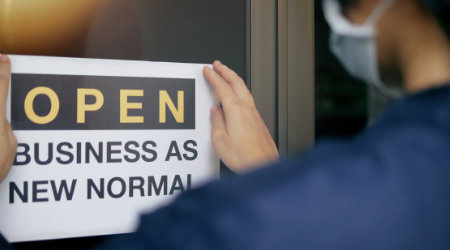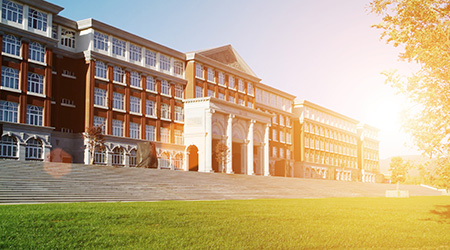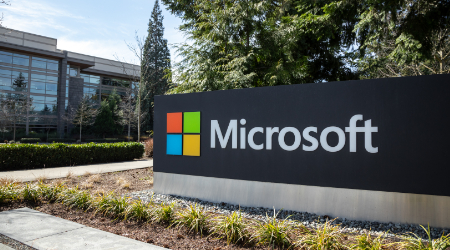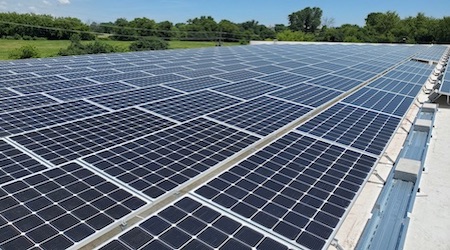
Case Study: Digital Ceiling Helps Telecom Giant Safely Reopen Its Office Amid the Pandemic
August 11, 2021
BuroHappold is a British professional services firm that provides engineering consultancy for buildings and infrastructure. When a British telecommunications giant upgraded its London headquarters to include LED lighting, controls, and sensors, its goal was to streamline building management, reduce costs, and minimize environmental impact. What the telecom provider didn’t know at the time is that the same digital ceiling would one day be used to help safely reopen its offices amid a pandemic.
Following a conversion to LED lighting and controls at its headquarters facility, BuroHappold’s client wanted to add layers of intelligence to the office to benefit employee well-being and operational efficiency. Several floors were outfitted with sensors from GE Current, a Daintree company, and other manufacturers to record temperature, humidity, carbon dioxide (CO2), light, noise, and occupancy levels throughout the day.
Beyond simple people-counting, the occupancy sensors specified by BuroHappold use passive infrared (PIR) paired with computer vision to provide real-time insight into where people are, thus helping to inform and administer safe social distancing practices for employees.
All told, 60 light fixtures illuminating over 6,020 square feet (560 square meters) were outfitted with environmental sensors. Workplace occupancy trends—including how staff physically navigate the office—were then tracked with the help of more than 100 line-counter devices placed at entry and exit points on each floor, as well as at the entrances of individual meeting rooms.
To have both an efficient building and a great environment for people, it is necessary to turn data into action. Most buildings leak energy and costs, but a bigger challenge is improving user experience and productivity. With sensor-enabled lighting infrastructure providing the evidence, BuroHappold selected its SmartViz workplace analytics platform to supply the insight that drives strategic decision-making.
Leveraging data from Current’s sensors and associated devices, the SmartViz dashboard provides instant visualization of how spaces are being used. The occupancy of entire floors, meeting rooms and “hot desks” is reported in real time, and trends can be identified through analysis of historic data. Environmental conditions including temperature, light, noise and CO2 are also reported to help maximize energy efficiency and the human experience, as well as to model “day in the life” scenarios relating to asset performance, operational spending and occupant comfort.
The SmartViz platform collates information such as floor space utilization, staff count and energy usage with values clearly shown via maps, dials and charts.
SmartViz provides a single intuitive application to unify myriad siloed data sets from every room and every floor where sensors are installed at the telecom company headquarters. With the COVID-19 pandemic still disrupting human behavior and work patterns, data and insights are more critical than ever to a firm’s success.
The team at BuroHappold, led by Dr. Shrikant Sharma, group director and head of Workplace Analytics, was able to use this data to model what the workplace would look like in a post-COVID world. They began by analyzing the office setup, including how the existing layout would affect the flow of people at full and reduced capacity. The challenge facing the telecom company was soon clear—initial models suggested floors could only be filled to 52 percent capacity to maintain social distancing.
In response, Dr. Sharma’s team deployed SmartViz to test different workplace layouts by combining historic, real-time and predictive data to determine how physical distancing might look within given floor plans. In one example, the team found that the floor could safely be filled to 86 percent capacity by changing the desk layouts. This simple modification would enable BuroHappold’s client to safely bring back a larger portion of its workforce sooner than expected.
The ability to quickly model change scenarios to transform workspaces is one of many benefits a combined data and analytics solution can bring to buildings.
Data from sensors that become actionable insights can make businesses safer and smarter, as BuroHappold and Current are proving. How workplaces will continue to adapt to the uncertainty of the pandemic remains unclear; what is known is that resilience increasingly relies on data, specifically the ability to predict, track and adapt at speed. One lesson many building owners are learning is that assumptions are no longer valid—proven data is the answer. Fortunately, the future of smart building management is more accessible than ever thanks to the power and potential of the digital ceiling.
Next
Read next on FacilitiesNet












